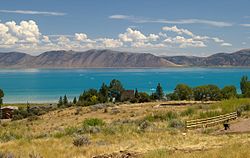Bear Lake (Idaho-Utah)
| Bear Lake | |
|---|---|

The lake's intense turquoise color is due to
the presence of suspended limestone |
|

Bathymetric chart
|
|
| Location |
Bear Lake County, Idaho Rich County, Utah, U.S. |
| Coordinates | 42°00′N 111°20′W / 42.000°N 111.333°WCoordinates: 42°00′N 111°20′W / 42.000°N 111.333°W |
| Primary inflows |
Bear River Creeks: Fish Haven, North Eden, South Eden, Swan Creek, St. Charles |
| Primary outflows | Bear Lake Outlet Canal |
| Catchment area | 5,862,957 acres (23,727 km2) |
| Basin countries | United States |
| Max. length | 18.3 mi (29.5 km) |
| Max. width | 7.1 mi (11.4 km) |
| Surface area | 109 sq mi (280 km2) |
| Average depth | 94 ft (29 m) |
| Max. depth | 208 ft (63 m) |
| Water volume | 6,500,000 acre·ft (8.02 km3) |
| Residence time | 19.6 years |
| Shore length1 | 48 mi (77 km) |
| Surface elevation | 5,924 ft (1,806 m) |
| Settlements |
Garden City, Utah, Laketown, Utah, Fish Haven, Idaho |
| 1 Shore length is not a well-defined measure. | |
Bear Lake is a natural freshwater lake on the Utah-Idaho border in the Western United States. About 109 square miles (280 km2) in size, it is split about equally between the two states; its Utah portion comprises the second-largest natural freshwater lake in Utah, after Utah Lake. The lake has been called the "Caribbean of the Rockies" for its unique turquoise-blue color, which is due to the reflection of calcium carbonate (limestone) deposits suspended in the lake. Its water properties have led to the evolution of several unique species of fauna that occur only within the lake. Bear Lake is over 250,000 years old. It was formed by fault subsidence that continues today, slowly deepening the lake along the eastern side.
Originally named "Black Bear Lake" by Donald Mackenzie, an explorer for the North West Fur Company who discovered the lake in 1819, the name was later changed to Bear Lake. The lake is a popular destination for tourists and sports enthusiasts, and the surrounding valley has gained a reputation for having high-quality raspberries.
The first known inhabitants of the Bear Lake Valley were Shoshone tribes, but the area was known to many Native Americans. The first record of whites seeing the lake is from 1818 when French-Canadian trappers working for the North West Company followed the Bear River upstream to the valley.
The south end of the lake, in the area of modern-day Laketown, was the location of a rendezvous in the summer of 1827 and 1828. Mountain men, including Jedediah Smith and Jim Bridger, gathered at this location, along with trade goods suppliers, and American Indians from several different tribes. The mountain men and Indians sold their furs in exchange for various store goods and supplies, and several weeks were spent reveling in assorted amusements and liquor.
...
Wikipedia
